Here's What It Was Like To Eat At The First Texas Roadhouse
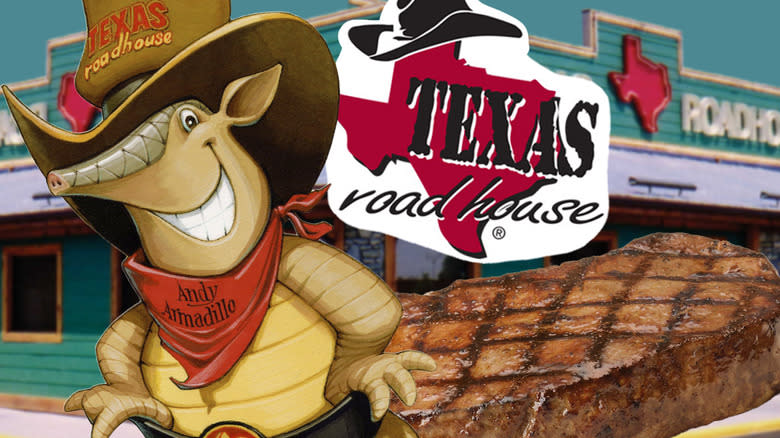
Texas Roadhouse is a steak-lovers heaven. It's one of the few international steakhouse chains that offers made-from-scratch food for an affordable price. Despite having a global footprint, Texas Roadhouse has managed to stick to its culinary guns since opening in 1993. Ironically, it began in Clarksville, Indiana, rather than The Lone Star State that it's modeled after. Fresh, quality food for cheap was founder Wayne Kent Taylor's vision from the beginning. In his 2021 memoir, "Made From Scratch," he shared his dream of offering Outback and Longhorn-level steaks, but at an Applebee's and Chili's price point.
To call it a successful strategy is an understatement. Today, over 600 national and 40 international Texas Roadhouse locations exist. It's been blazing saddles for over 30 years now. Even with the meat industry's recent supply shortage, and Texas Roadhouse raising its prices, you'll still find budget-friendly cuts without breaking the bank. Like any success story, a lot has changed since the humble beginnings. Here's what it was like to eat at the first Texas Roadhouse.
Read more: The Most Popular Cuts Of Steak Ranked Worst To Best
Immersing Yourself In Texas-Style Aesthetic
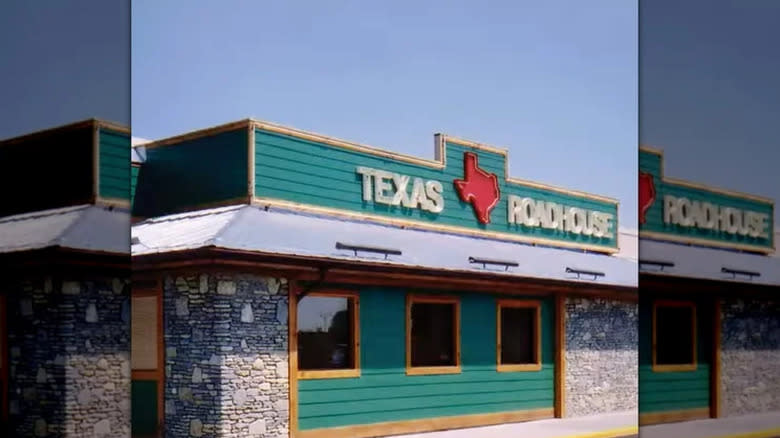
Reliably-priced, made-from-scratch food is only one reason to love Texas Roadhouse. As soon as guests walk in, they are greeted by a rustic Texan aesthetic. Like the American settlers of old, the original Texas Roadhouse location was a pioneer in Clarksville, Indiana's food scene. Wayne Kent Taylor envisioned an immersive setting that looked, sounded, and tasted like Texas. Against a backdrop of line dancing and lively country music, patrons of all ages could feel like a Texan for the day.
Pictures of the original location's interior are scarce, but one can assume that it contained many of the same characteristics: wooden booths, vintage beer posters, and cowboy-esque memorabilia on the wall. We do know how it looked on the outside.
The exterior was made of stacked cobblestones and woodsy green wooden panels with light brown trimming. An earlier version of the Texas Roadhouse sign with neon light letters and a hatless red-colored state was displayed on either side of the building. Like the current sign, it too was outlined with neon lights.
A Throwback Rustic-Style Logo

Wayne Kent Taylor's vision for Texas Roadhouse was clear at the start. From the original location, which used the same classic white, red, and green colorway, to the logo, which featured the brand's ubiquitous cowboy hat-wearing Texas state. The first company logo had only two colors; a maroon Texas with a black cowboy hat and "Texas Roadhouse" in a rough-and-tumble font style. It only lasted a year before being updated to include the resident mascot "Andy the Armadillo" in place of the resting black cowboy hat.
With the addition of the gray and yellow-colored mascot, the black outline behind the Texas state was replaced with yellow. It was the official logo for seven years until 2001 when it received the most drastic update. Andy was removed and the iconic cowboy hat-wearing Texas state returned, but was shrunken and changed from red to the current green color. Adjusting the size of the state brought the restaurant name into focus, which now had a font that replicated the real-life neon light sign. While there were subsequent changes, the newer logos are technically just the 2001 logo with minor alterations.
Line Dancing And Country Music
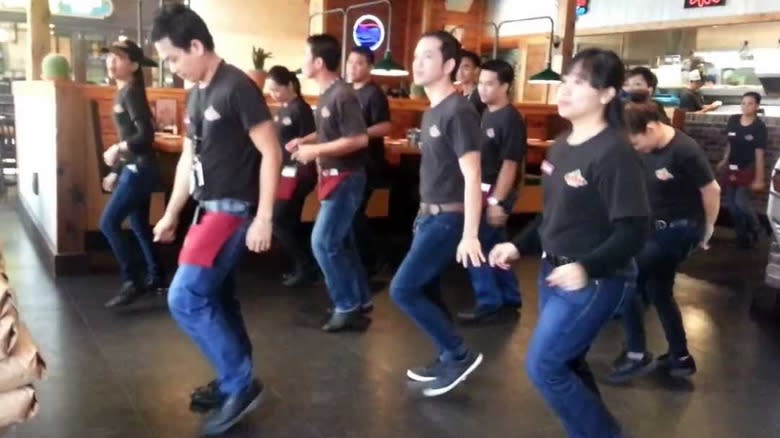
To give you the best down-home foodventure possible, Texas Roadhouse pulls out all the stops. The aesthetic and impressive dining experience are only part of the immersion, there are also line-dancing employees and high-spirited country music. Line dancing is, in fact, a common form of entertainment at many Texas Roadhouse locations. At some places they crank up the country music every hour, others every 30 minutes. And while you won't be asked to swing your partner do-si-do, you're more than welcome to join in — even Texas Roadhouses in other countries do it.
Line dancing employees and country music are part of Texas Roadhouse's origin. These days, Texas Roadhouse employees sometimes compete in annual line dancing competitions where teams from various locations face off. That said, having line dancing as a job requirement has spurred some controversy in recent years. Many feel that employees shouldn't be forced to dance and serve, especially when they are only being paid minimum wage. Many employees also, however, seem to get a kick out of the extra entertainment.
The Original Menu Introduced Staples Still Popular Today
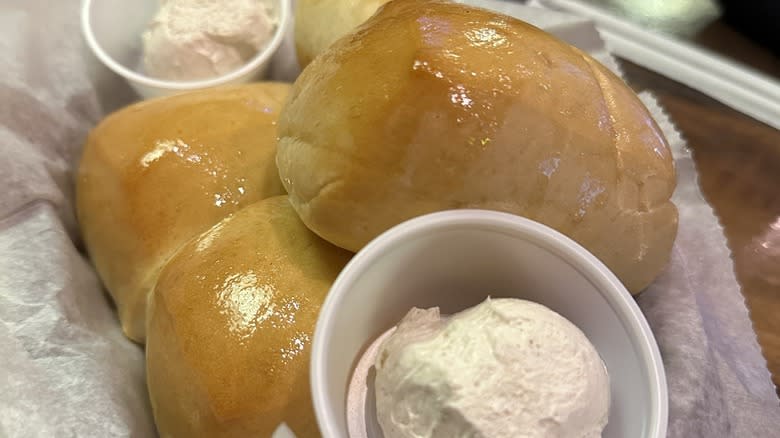
Steak was already Indiana's premiere protein when Texas Roadhouse opened. The restaurant's unique aesthetic and service style, plus affordable pricing, separated it from other steak-serving spots in Clarksville at the time. With a made-from-scratch ethos, customers could enjoy fresh food daily and even pick their own steak cut.
The 6-ounce sirloin was the top seller in 1993 and still is today. Taylor and his team spent three weeks testing various types of yeast and flour to find the perfect mixture for the restaurant's iconic dinner rolls.
Interestingly enough, before settling on free dinner rolls and peanuts, he almost chose free popcorn instead. He also attempted to sell Mexican food, presumably from a desire to represent Texas's wider culinary landscape, but that was short-lived. The signature Legendary Margarita, did however, make the original menu and is still one of the restaurant's most popular items.
Employees Leaving To Use The Bathroom At Nearby JCPenney

In Wayne Kent Taylor's 2021 book "Made From Scratch: The Legendary Success Story of Texas Roadhouse," he provides hilarious insight into the early days of the restaurant. One story is about how the restrooms were still under construction, even as opening day loomed around the corner. Taylor was a resourceful man, so he went to JCPenney's next door and used free meals to persuade the manager to let him and his employees use the restroom — but only for around a month.
He eventually decided to move ahead with the opening sans-working bathroom, having already made wedding plans for March 20, which was only a month after the scheduled launch. The JCPenney manager had reached his hospitable limits though, and soon after opening day, walked in with seething intensity. Taylor noticed a trail of peanut shells leading to the restrooms as he followed him back to JCPenney's. The bathrooms were still two weeks out from completion, so Taylor jokingly called the situation positive and said that patrons would "just follow the peanut trail."
After the joke didn't stick the landing, he offered a possible caveat, "I bet if you check the departments along the trail, you are going to see their sales are up." Unamused, the manager accepted the two additional weeks in exchange for more free meals. He returned days later with a change of heart after confirming that sales had indeed increased thanks to their agreement.
The Restaurant's Iconic Mascot Andy The Armadillo
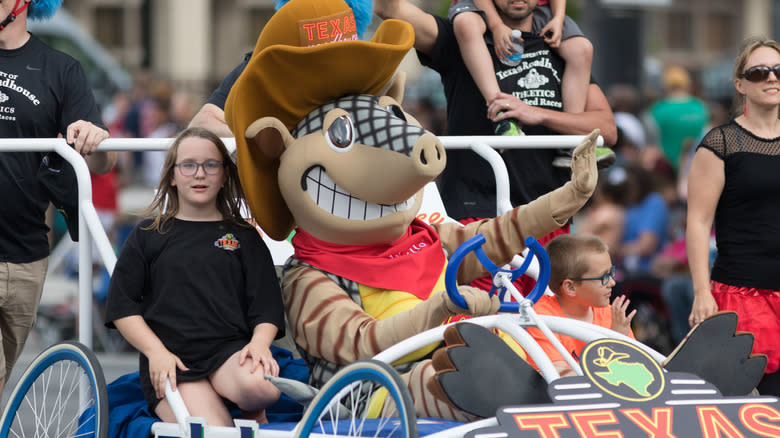
If the honky-tonk Texas setting doesn't suspend your disbelief, the resident mascot will. Andy the Armadillo has been keeping customers in good spirits since the beginning. He's another one of Taylor's genius ideas inspired by the restaurant's family-friendly concept and The Lone Star State, which happens to host the largest population of armadillos in America. If you're unfamiliar with these cat-sized armored creatures, the armadillo is Texas' official state small mammal. Its body is covered in a bony shell with scales that protect it from predators. Andy was born to the first Texas Roadhouse in 1993, and was a part of eating there.
Unlike real armadillos, Andy is a tan, gray, and yellow-colored bi-ped who wears a black belt, golden-brown cowboy hat, and red bandana around his neck. A massive smile is perhaps his most standout characteristic. He began as just an illustration before the life-sized costume was introduced. There isn't much information about Andy's earlier days, but as we've covered, he was added to the second iteration of the logo in 1994.
It Started Off And Still Is A Dinner-Only Concept
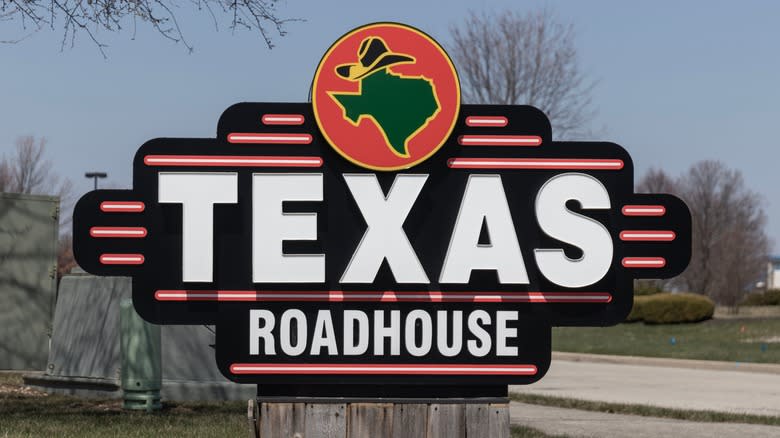
High-quality affordable food and weekend-only dinner service is the recipe for Texas Roadhouse's success. According to the company, restaurant serves 544,000 meals each day. But had you arrived at the first Texas Roadhouse for a weekday lunch, you would find it closed. That remains the same today.
Wayne Kent Taylor decided to make it a dinner-only concept during the week to support managers, who often work harrowing hours that negatively impact their lifestyle. The systemwide rule is that the only time Texas Roadhouse locations opens for lunch are on the weekend.
One instance in which Taylor relented his dinner-only policy was during the pandemic when locations temporarily transitioned to takeout-only. He nevertheless refused to offer a third-party delivery option, claiming that it might compromise the quality. In the past, some locations have added to-go lunch, but only for a limited time. Texas Roadhouse has also tested a drive-thru service, though it never became a standard. The global chain is still first and foremost a dinner-only concept, like it always has been.
Waiters Served Fewer Tables And Gave More Attention
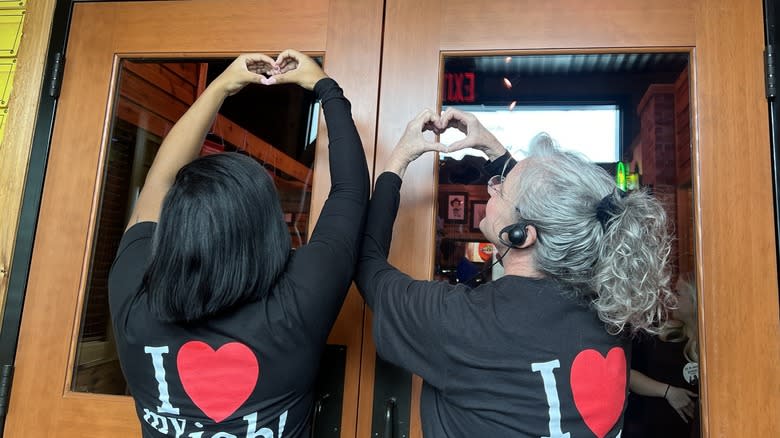
A down-home experience isn't the only thing Texas Roadhouse brought to Clarksville, Indiana, it also introduced a new service style that contributed to its early success. Wayne Kent Taylor's strategy included a plan called "three-table stations" where servers are only assigned three tables at a time. The industry norm is that servers are required to wait four to six tables at a time. The three-table system allowed customers eating at the first Texas Roadhouse to receive more attention, and lowered the possibility of flubbing up orders.
Over the years, Texas Roadhouse has received many awards for its customer service, proving Taylor's strategy sound. In 2021, it was ranked #3 on Newsweek's list of America's Best Customer Service for Casual Dining Restaurants. That's only one of many awards it has received for quality customer service. If anything, Taylor loved to go against the grain. Fun fact: He initially recruited the staff of the first Texas Roadhouse (and others) by lifting them from other restaurants —presumably convincing them with a mixture of charisma and opportunity.
Read the original article on Tasting Table.


